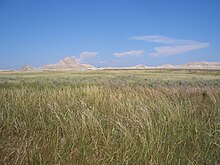Buffalo Commons
With the English word Buffalo Commons (dt. About buffalo commons ) is a project in the Great Plains (Dt. Great Plains ) in the middle of the United States of America ( USA ), respectively. In response to the massive population decline since the 1960s and increasingly from the late 20th century, demographic development and the state of the time before the influx of white settlers in the second half of the 19th century are to be restored. After the great, devastating dust storms of the 1930s (see Dust Bowl ), these have largely moved to more fertile coastlines further west of the Rocky Mountains .
The plan was drawn up by land use planner Frank Popper, professor at Rutgers University and Princeton University , and his wife, geographer Deborah Popper. His goal is that again large areas of the land come into public ownership, on which again large herds of buffalo can roam the vast plains of the prairie . Before the almost extermination by the white settlers, hundreds of thousands of these animals lived here in a coexistence characterized by extensive use with the prairie Indians who also lived here . By marketing the buffalo meat and in particular income from tourism, a permanent economic basis is to be created for the declining population of the Great Plains.
situation
The trend towards industrial agriculture with large fields and pastureland, the lack of attractiveness of rural regions for younger and well-educated generations and the resulting demographic development have resulted in large parts of Kansas and Nebraska , North and South Dakota and adjacent parts of Oklahoma and Montanas , and parts of Texas and Colorado are less populated today than they were in 1893. In that year, the settlement of the United States was assumed to be complete according to the Frontier thesis of Frederick Jackson Turner. In Kansas alone, over 6,000 settlements were completely abandoned. The development continues to accelerate.
In addition, all agriculture in the Great Plains relies on the use of prehistoric groundwater from the Ogallala aquifer . In the decades of intensive agriculture, the stocks have been exploited far beyond a sustainable level; the drying up of the water supply is imminent in some regions. Large-scale irrigation farming with today's methods can no longer be sustained for much longer.
The concept
The concept of the Buffalo Commons provides that large-scale agriculture in the Great Plains is abandoned in favor of pasture use by largely wild bison. The plan assumes that in addition to the expected new tourism , the marketing of the meat of the wild buffalo can bring the people of the region a more secure future again. It is already leading to the fact that the descendants of the Indians who used to live here return to deal with the animal with which they are inseparably linked according to their mythology .

In addition, the Community would bring land use with the buffalo breeding and husbandry, according to the couple's Popper also great environmental benefits to revive the agricultural by the (private) (over) use (wheat) is partly to desertification desolate tracts of land with it. Buffaloes feed on the native prairie grass, contribute to its re-distribution and can use water in the very dry zone much better than the cattle imported and kept here ; in addition, they are also significantly more resistant to cold .
After initially pronounced skepticism, especially from critics of state (land use) planning, the idea is gradually gaining greater support among politicians, farmers , ranchers and the Indians mentioned above; In addition to demographic and sociological successes, there are already first economic and ecological successes as well as a significant increase in the buffalo population.
A variant would be on the border between Kansas and Colorado all surfaces in private ownership in the two counties Greeley and Wallace County (both Kansas) to buy what something would be required under a billion dollars of market value. A new national park should then be created there. The two counties are the most sparsely populated in Kansas, and agriculture there suffers particularly from depletion of groundwater supplies. Villages in the vicinity of the park could specialize in tourism services. Funding would be provided by income from the Land and Water Conservation Fund , which comes from user fees for the exploitation of natural resources on public land and is accounted for by the Office of Natural Resources Revenue . This variant was applied and publicly represented by the Kansas Star newspaper in late 2009 .
literature
- Debora and Frank Popper: The Buffalo Commons as Regional Metaphor and Geographic Method , Geographical Review (accepted draft)
Web links
- Great Plains Restoration Council: Research: Buffalo Commons
- Jörg Blech: Serengeti in Montana , Der Spiegel, 42/2008, page 158
- Wil S. Hylton: Broken Heartland: The looming collapse of agriculture on the Great Plains . In: Harpers , July 2012
Individual evidence
- ↑ High Country News: Plains sense , Jan. 15, 2001
- ↑ Nikolas D. Kristof: Make Way for Buffalo , New York Times, October 29, 2003
- ↑ Kamil Taylan and Wolf Truchsess von Wetzhausen: The Return of the Buffalo , ZDF film documentary, broadcast date on ARTE: January 22, 2008 ( information about the program ( Memento of the original from July 9, 2010 in the Internet Archive ) Info: The archive link was inserted automatically and not yet checked. Please check the original and archive link according to the instructions and then remove this note. )
- ^ Kansas Star: A new park to save the plains. November 15, 2009, Section B, page 7


